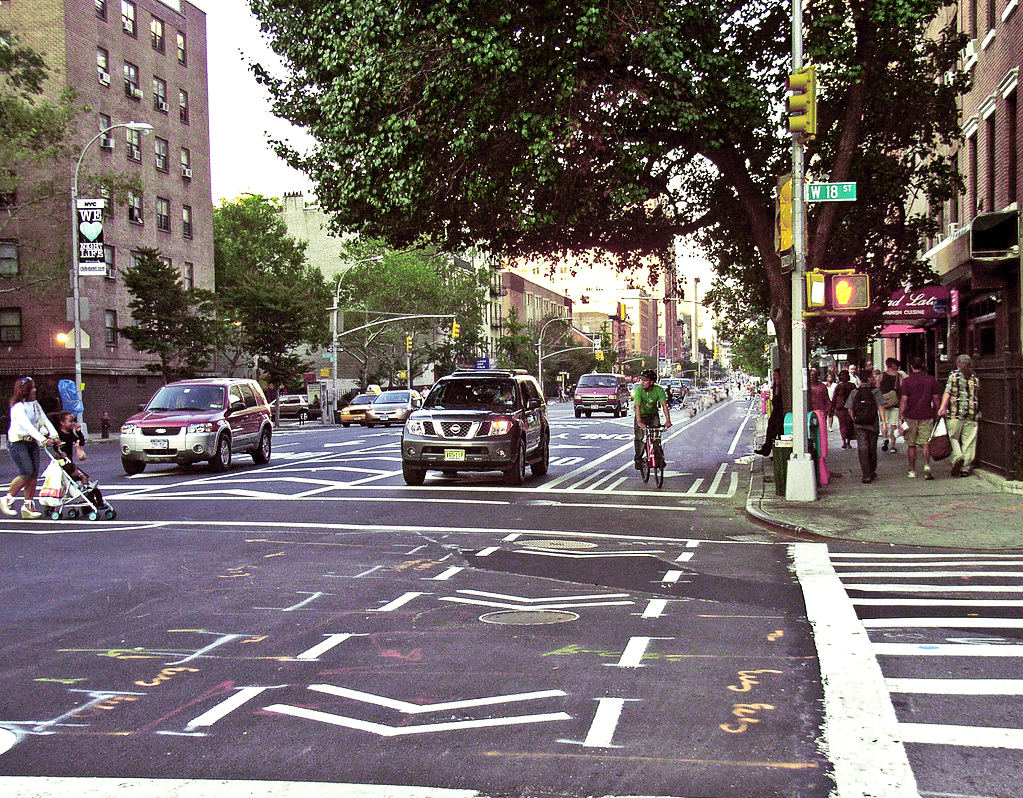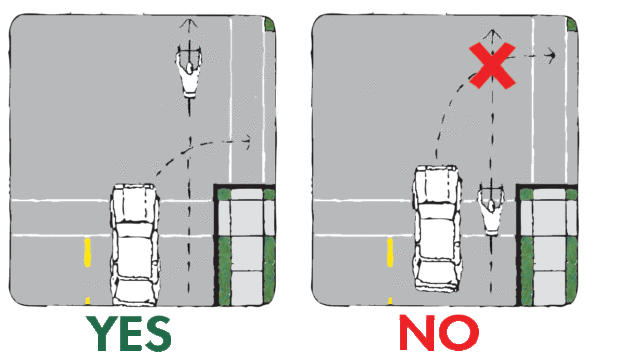November 5, 2019
Ride Tip of the Month, November 2019: How to Dodge the Right Hook

Just like in boxing, a “right hook” crash can knock an unsuspecting cyclist out–with potentially deadly consequences. But when motorists and riders commit to practicing safe road-sharing practices and exercise special precautions at intersections and driveways, the risk of collisions drops dramatically. In this month’s blog, Bike New York’s Education Director Rich Conroy shares some useful pointers to help readers dodge the right hook.
What is a right hook crash?
While vehicles and cyclists are stopped at intersections or driveways, they’re at risk for a right hook situation–when the motorist turns right as the cyclist continues straight, leading to a collision. These crashes generally occur for one of two reasons: either the motorist passes the cyclist shortly before making a right turn, leaving the cyclist nowhere to maneuver except directly into the side of the turning vehicle; or the cyclist enters the motorist’s blind spot while riding beside or passing on the turning vehicle’s right side.

Motorists should never pass a cyclist immediately before making a turn. Be aware of cyclists alongside your vehicle, and wait until they clear the intersection before you proceed. (Credit: mybikeadvocate.com)
Every trip comes with some risk of incident, but with a few quick changes in behavior on the road, both riders and drivers can do their part to reduce the risk of right hook collisions.
If you’re a cyclist:
- Take the lane–that is, ride in the center of the lane–as you approach an intersection or driveway where a right turn seems likely. This will deter dangerous passing and may even force drivers to wait behind the cyclist before they proceed with making a turn.
- As you ride, think ahead: be aware of situations where motorists are likely to make right turns and watch the flow of traffic to assess motorist behavior; drivers who are about to turn will often slow ahead of an intersection. Try to stick to the same commuting route for several days in order to get a feel for which areas driver favor while making turns. It might sound like a lot to take in but, ultimately, an observant cyclist is often a safe cyclist.
- When riding with moving traffic, choose to take the lane behind slower vehicles and pass them on the left side. While approaching an intersection, never ride along the right side of vans, trucks, semi-trucks or buses. Even riding along the right side of passenger vehicles in these situations can prove dangerous.
- Be aware that separated bike lanes and bike paths adjacent to roads have their own dangers at intersections when it comes to turning motorists–for instance, Battery Park City in Lower Manhattan has many street crossings where motorists on the West Side Highway (aka West Street) can turn right at every intersection. Even when cyclists have the green light, it’s always a good idea to check the turning vehicles in the right lane to confirm that they’re stopping.
- Be alert and cautious at each and every intersection you approach, even when you have a green light. As a rule, always avoid riding off the sidewalk into an intersection; riding on the sidewalk is against the law for teens and adults in NYC, and it’s regarded as a dangerous cycling practice in general.
If you’re a motorist:
- Be aware of the presence of right-side cyclists, especially when you’re both approaching an intersection. It’s a safer choice for everyone to make your turn behind a cyclist rather than racing ahead to complete your turn.
- When driving on roads and streets parallel to a separated bike lane or a bike path, be sure to stop, check for approaching cyclists, yield if you both have a green light, and proceed once the intersection is clear.
- Always use turn signals so that cyclists coming up from behind are warned that you are turning right.

Cyclists should avoid riding on the right side of large vehicles; instead, take the lane behind them, which puts you in a good position to pass a slow-turning vehicle on the left. (Credit: New York City Department of Transportation).

